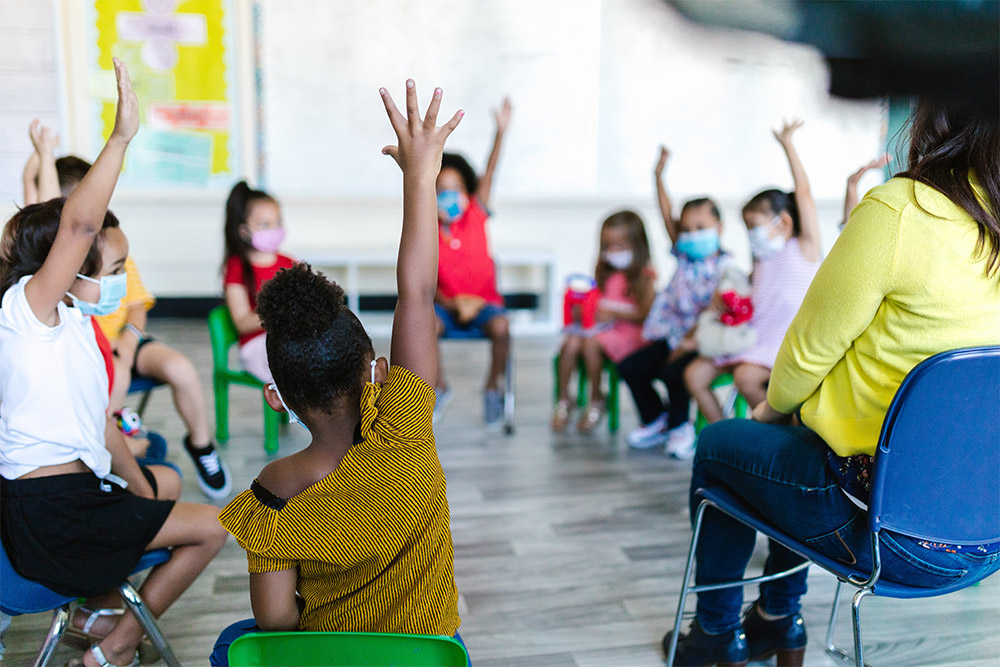Reframing our Goals for Mathematics Education: The Importance of Nurturing a Sense of Belonging
By Babette Moeller
“… people will forget what you said, people will forget what you did,
but people will never forget how you made them feel.”
—Maya Angelou
Think of a situation where you felt you belonged. What was that like? What made that happen for you? Consider a time when you sensed that you didn’t belong. How did you feel? What made you uncomfortable? And what do these questions have to do with teaching and learning mathematics? You will find out in this blog.

But first, let me start with the obvious: just like reading, learning mathematics is not optional. Calculating the interest on a student loan, appreciating the symmetry in a beautiful painting, understanding election results, figuring out how to scale a recipe for two to serve a party of ten, determining the amount of paint needed to cover the walls in a room, estimating the time it takes to travel to a destination, and recognizing the pattern in a melody are just some examples of the ways mathematics is all around us and essential to leading productive and joyful lives. To prepare students for meaningful participation in our 21st-century society, it is imperative for schools to help all students, regardless of their backgrounds, become proficient with mathematics.
A common metric for assessing students’ proficiency in mathematics is students’ performance on standardized tests. Recent test results, such as those from the 2022 mathematics assessment of the National Assessment of Educational Progress, have shown glaring performance differences along racial, ethnic, and socio-economic lines, as well as by ability status and language background. The COVID-19 pandemic has only made these worse. Academic performance clearly is an important indicator of student learning, but all too often a narrow focus on improving student performance on achievement tests—rather than a focus on improving students’ learning and understanding of mathematics—has been the primary goal for driving improvements in mathematics education.
There is growing recognition that to adequately improve student learning of mathematics and to address performance gaps between students from different backgrounds, we need to focus on a more fundamental construct, which is improving students’ sense of belonging in mathematics. Belonging is an essential human need, and can be broadly defined as the feeling of connection and acceptance or “fitting in.” Research has shown that a student’s sense of belonging is positively associated with student outcomes, such as their motivations, grades, interest in a field of study, and the intent to pursue college or persist in a discipline. Belonging is particularly important for historically marginalized students, who are more likely to experience exclusion and uncertainty about whether they belong in certain contexts, including at school. Therefore, helping students develop a sense of belonging is a more useful goal compared to just focusing on academic performance; it lets us see the whole child more fully and equips us to plan our teaching better. It puts an emphasis on nurturing students’ feelings and beliefs about what they have to learn and how best to engage them. It also highlights the need to focus on ALL students, particularly on those who have been marginalized and who may need extra support in developing a strong feeling of belonging. To give you a feel for what a belonging-rich classroom might look like, check out this 5-minute video.
How Students Might Experience Belonging in the Mathematics Classroom
As with any other discipline, belonging is important for learning mathematics. Children who feel they don’t belong in mathematics won’t learn mathematics. Students who have a sense of belonging in their mathematics classrooms likely experience these feelings:
- Their thinking and approaches to mathematics are respected, valued, and accepted by their teachers and peers.
- They have a personal interest in mathematics and see its relevance to their lives.
- They have the confidence to share what they actually think about a topic or a problem, rather than feeling they need to come up with a response that a teacher or textbook expects of them.
- They can succeed even if they make mistakes or run into obstacles (i.e., they have self-efficacy and a growth mindset), and their teachers have high expectations for them to grow and learn while providing the support for them to experience success.
- They have agency in mathematics, i.e., they feel empowered to contribute to and shape the mathematics learning environment they are in.
- They own mathematical ideas because they have reasoned them through, rather than just having memorized information.
They are “a math person” and are recognized for their contributions to the mathematical discourse in the classroom.
Strategies for Nurturing a Sense of Belonging in the Mathematics Classroom
For students to learn mathematics, they must develop a sense of belonging in this discipline. We, as teachers, are the most powerful force for fostering a sense of belonging in mathematics. To do so requires ongoing efforts. Here are some strategies to get started.
- An important way to begin helping students develop a sense of belonging is to understand and value learner variability. Know your students’ strengths, challenges, and interests.
- A commitment to fostering belonging for all students requires us to examine our own words and actions.
- Avoid messaging that mathematics is not for everyone (i.e., that there are people who are “math persons” and people who are “not math persons”) and affirm that everyone belongs. Be aware of cultural messages about who is supposed to do well in mathematics, and find ways to counteract those messages.
- Shift away from focusing teaching on the (hypothetical) average student, which ignores students’ individual identities and sends a message to the students who differ from the average that they don’t belong. Instruction has to be differentiated based on individual students’ strengths and challenges in order to provide all students with meaningful access to high-quality mathematics. Instead of viewing students as flawed, we need to focus on the learning environment and examine the ways it enables or disables feelings of belonging and learning.
- Establish classroom norms that support a safe and respectful learning environment in which the classroom community accepts that everyone belongs in mathematics, and where making mistakes and productive struggle are viewed as an important part of the learning process.
- Use accountable talk sentence stems to scaffold meaningful and respectful discourse around mathematical ideas.
- Connect to students’ lived experiences to build on their strengths, validate their identities, and help them see the relevance of mathematics in their own lives. Utilizing this approach will also give you opportunities to learn more about your students. The following are some examples of how you can implement this strategy.
- Conducting mathematics “Show and Tell”—have students share and discuss a picture or an object that illustrates mathematics in their home or community.
- Using notice and wonder routines to allow students to share their perspectives and have them validated.
- Engaging students in mathematics projects that are relevant to them (e.g., conducting a survey and analyzing data about a topic that is of interest to them).
- Use open-ended and rich math problems that have multiple answers and reveal student thinking, instead of problems that require only one correct answer.
- Provide opportunities for student choice and decision making in mathematics (e.g., what problem to work on, how to approach a problem, what tools to use, how to explain or show their thinking). Giving students a choice is intrinsically motivating as it allows them to assume ownership of their learning and creates a uniquely personal and authentic product.
- Be intentional in how you structure social interactions in the classroom (e.g., which students to pair up, what protocols to use for small-group and large-group work) to help students build positive relationships with each other.
- Help students learn about their strengths, interests, and the areas they need to work on. Support students to set and reflect on goals for their learning, and encourage students to self-advocate to get the support they need.
- In order for students to belong, their teachers also need to feel a sense of belonging. If you don’t feel a strong sense of belonging in mathematics, seek out opportunities to challenge your beliefs. For instance, do some math with your colleagues, or join a professional learning community that focuses on mathematics. Find the places where you have choice, voice, and authority in teaching mathematics and utilize them.
A sense of belonging is an essential precursor to learning, including in the mathematics classroom. To help each student develop a sense of belonging and the mathematical proficiencies needed to lead productive lives, we need to intentionally create mathematics learning environments that actively include and value each student’s ways of learning. Doing so promises to bring joy not only to learning, but also to teaching mathematics.

Reflection and Discussion Questions
Use the questions below to guide self-reflection, a conversation with a colleague, or a discussion at a faculty meeting.
- What is the advantage of focusing on belonging rather than just academic achievement as a goal for mathematics education?
- What is your sense of belonging in mathematics? Why do you feel that way?
- What is your students’ sense of belonging in mathematics? Are there some students who have a stronger sense of belonging than others? Why might that be?
- How can you nurture a culture of belonging in your school?
- What are three things that you might want to start, stop, and keep doing to help your students develop a deeper sense of belonging in your math classroom?
The contents of this blog post were developed under a grant from the Department of Education. However, those contents do not necessarily represent the policy of the Department of Education, and you should not assume endorsement by the Federal Government.
This work is licensed under CC BY-NC-SA 4.0
Math for All is a professional development program that brings general and special education teachers together to enhance their skills in
planning and adapting mathematics lessons to ensure that all students achieve high-quality learning outcomes in mathematics.
